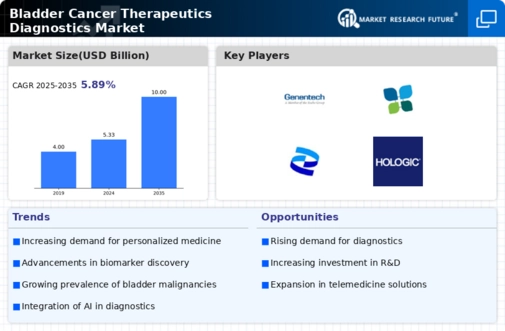The competitive insights of the Bladder Cancer Therapeutics Diagnostics Market reveal a landscape marked by innovation, strategic partnerships, and a diverse range of treatment options tailored for patients.
This market is characterized by a growing demand for advanced diagnostic tools and therapeutics aimed at improving patient outcomes and enhancing the quality of life for individuals battling bladder cancer.
The presence of established pharmaceutical companies and emerging biotech firms contributes to a competitive arena where research and development play a critical role. In addition to product launches, mergers and acquisitions are common as companies strive to expand their portfolios and strengthen their market positions.
The integration of cutting-edge technologies, such as precision medicine and biomarker discovery, is increasingly shaping the future of bladder cancer therapeutics and diagnostics, driving competition among key players.
Roche Holding AG is a significant entity in the Bladder Cancer Therapeutics Diagnostics Market, known for its robust portfolio of medications and diagnostic solutions designed to target specific cancer types, including bladder cancer. The company benefits from a strong research and development foundation, allowing it to introduce innovative products that meet specific clinical needs.
Roche's extensive global reach enables it to maintain a competitive edge while also ensuring that its therapies are accessible to a wide patient population. Its investment in personalized medicine and the identification of specific biomarkers showcases its commitment to providing tailored treatment options, thus enhancing the efficacy of its therapeutic offerings in the context of bladder cancer.
With its well-established reputation and a commitment to continuous improvement in both therapeutics and diagnostics, Roche Holding AG remains a formidable player in this competitive market.
Genentech Inc is another critical contributor to the Bladder Cancer Therapeutics Diagnostics Market, recognized for its pioneering efforts in biopharmaceutical development and commitment to improving patient care.
The company's focus on innovative therapies, particularly in immuno-oncology, has positioned it as a leader in the market, attracting attention for its potential to revolutionize treatment paradigms for bladder cancer.
Genentech's strong emphasis on clinical trials and research allows it to stay ahead of the curve in terms of discovering and developing new treatments. Its collaborative approach, including partnerships with academic institutions and research organizations, further strengthens its position in the market.
By focusing on developing a comprehensive understanding of bladder cancer pathology, Genentech Inc is working towards delivering impactful therapeutic solutions that address unmet needs within the sphere of bladder cancer care.


















Leave a Comment